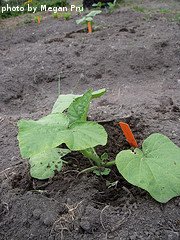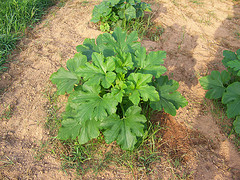Need Information About Planting Butternut Squash?
When planting butternut squash, it's best to sow the seeds where you want the plant to grow for the duration of the growing season. Squash plants don't tolerate having their roots disturbed. If you try and transplant seedlings, you're asking for trouble.
Butternut squash should be planted no earlier than 2 weeks after the last expected frost in your area. They can be planted up until 12 weeks or so before the first expected frost in the fall. It's possible to grow two butternut squash crops in a single year in warmer climates. The seeds germinate best when the soil temperatures are around 65 degrees F. Some folks with limited space wait to plant butternut squash after early spring crops such as lettuce and peas have finished. This is a good way to maximize garden space.
If you live in a cooler climate and need to get a head start by sowing seeds well before the last expected frost, sow them in a biodegradable container. This way, you don't have to remove the seedling from a pot when you transplant it, which can cause the seedling to fail. Instead, you can just transplant the whole biodegradable container with the seedling inside into your garden. Over time, the pot will break down and the squash roots will easily be able to spread out into the surrounding soil.

When planting butternut squash in a traditional vegetable garden, make sure the soil is well tilled down to a depth of 8 inches. Loose soil will give roots lots of room to develop and expansive root system. Nutrient rich soil will also help the plant grow large, which will allow it produce better quality squash. If you want to grow organic butternut squash, now is the time to add compost or well-rotted manure. Go ahead and till it into the soil when preparing your squash patch. We scatter a balanced granular fertilizer in our squash patch about a week before we plant. We water it in well and then till one last time. We also scatter pulverized lime as our soil is a bit acidic and denser, like clay.
After the soil is well tilled, create hills or mounds of dirt about 18-24 inches across and 8-12 inches high. If you are planting bush varieties, space the mounds 3-4 feet apart. If you are planting vining varieties, allow 6 feet between mounds. Remember to choose a location that gets plenty of direct sunlight - at least 6-8 hours per day.
After the hills are constructed, use your finger or the end of a hoe or trowel to poke 2 holes in the top of each mound. The holes should be about 1 inch deep and a few inches apart. Drop a single seed into the bottom of each hole and cover it with loose soil. After you've finished planting butternut squash seeds, water them in thoroughly. When the seedlings reach 2 inches tall, thin to one plant per mound, keeping the best looking seedling. Thinning is necessary to make sure the plants have plenty of room to grow and aren't competing with each other for valuable water and nutrients.
If you want to plant butternut squash in containers, choose a compact variety. Look for the terms "bush", "compact" or "space saver" on the seed packet. You do not need to create hills if planting in a container. Choose a container that is at least 36 inches across and 18 inches deep. A good option is an old whiskey barrel that has been cut in half. Make sure there are adequate drainage holes in the bottom of the container. Be sure to use a nutrient rich potting soil or top soil. Don't forget to put the container in a spot that gets 6-8 hours of daily direct sunlight. Poke holes in the soil and drop the seeds in. Cover the seeds with soil and water them in well. Plant 2-3 seeds per container and thin to 1 plant per container when the seedlings reach 2-3 inches tall.
If you want to save space in your garden, you can grow vining varieties of butternut squash vertically. Just make sure to put a sturdy support structure in place and choose a variety that produces smaller squash so that when they mature, their weight won't put too much stress on the plant. Trellises and fences make good support structures.
Now that you're done planting butternut squash, it's time to think about watering and fertilizing your plants.

Click here to learn about watering and fertilizing butternut squash plants
Click here for help diagnosing and curing common butternut squash plant problems
Click here to learn about harvesting butternut squash
Click here for some of our favorite butternut squash recipes
Click here for information about different butternut squash varieties
Click here to move from our Planting Butternut Squash page to our Growing Butternut Squash main page
Click here to return to our Home page